The Scientific Evidence Against The Big Bang
A Summary from LPPFusion, Inc.
The contradictions between Big Bang theory predictions and observations are not at all limited to those that have been widely dubbed a “Crisis in Cosmology”. Despite the continuing popularity of the theory, essentially every prediction of the Big Bang theory has been increasingly contradicted by better and better data, as shown by many teams of researchers. The observations are, on the other hand, consistent with a non-expanding universe with no Big Bang. The real crisis in cosmology is that the Big Bang never happened.
Key contradicted predictions (detailed descriptions below):
1) Light elements: Lithium and Helium
Prediction: Any superhot explosion throughout the universe, like the Big Bang, would have generated a certain small amount of the light element lithium and a large amount of helium.
Observation: Yet as astronomers have observed older and older stars, the amount of lithium observed has gotten less and less, and, in the oldest stars is less than one tenth of the predicted level. The oldest stars near to us have less than half the amount of helium predicted. However, well-understood fusion processes in stars and reactions initiated by cosmic rays have accurately predicted the correct amounts of these and other light elements.
2) Antimatter-matter annihilation
Prediction: Since the intense radiation of the Big Bang would produce matter and antimatter in equal amounts, mutual annulation of particle-antiparticle pairs would reduce the surviving matter density to around 10 -17 protons/cm3.
Observation: the matter density in the universe is observed to be at least 10 -7 ions /cm3 more than 10 billion times higher than the Big Bang prediction.
Big Bang fix to prediction: To try to fix this well-known vast gap, Big Bang theorists have proposed some unknown asymmetry between matter and antimatter which would lead to more production of matter. This has never been observed in laboratory experiments. A consequence of this predicted imbalance is the decays of the proton, initially predicted to decay with a lifetime of 1030 years. Large scale experiments have contradicted this prediction was well, with no evidence of decay at all.
3) Surface-Brightness
Prediction: In any expanding universe, an optical illusion makes objects at high redshift appear larger and dimmer, so their surface brightness—the ratio of apparent brightness to apparent area—declines sharply with redshift.
Observation: Based on observations of thousands of galaxies, surface brightness is completely constant with distance, as expected in a universe that is NOT expanding.
Big Bang fix to Prediction: After observations showed that the surface brightness dimming did not occur, Big Bang theorists hypothesized that galaxies were much smaller in the distant past and have grown greatly. But observations have contradicted this fix as well, showing that there have not been enough galaxy mergers for the growth rates needed. In addition, the ultra-small galaxies hypothesized would have to have more mass in stars than total mass, an obvious impossibility.
4) Too Large Structures
Prediction: In the Big Bang theory, the universe is supposed to start off completely smooth and homogenous. Structure starts small and grows over time
Observation: As telescopes have peered farther into space, huger and huger structures of galaxies have been discovered, which are too large to have been formed in the time since the Big Bang.
5) Cosmic Microwave Background Radiation (CMB) and its Anisotropies
Prediction(Initial): The CMB is a smooth relic of the initial radiation of the Big Bang
Observation: The CMB is smooth on such large scales that , in a Big Bang there would be too little time for regions that we now see in different parts of the sky to reach equilibrium with each other, or even to receive energy from each other at the speed of light.
Big Bang fix to prediction: An unknown force, dubbed ”inflation” generated an exponential phase of the Big Bang that blew up the universe so rapidly that all asymmetries were smoothed away.
Additional observations: The actual very small anisotropies in the CMB were much smaller than those predicted by Big Bang theorists and additional fixes had to be added to the theory each time the observations became more precise, so that at present seven free variables—the density of dark matter, of ordinary matter, of dark energy and four additional fitting parameters—are needed to fit the observations. They still badly fail with some of the largest-scale anisotropies
The latest crisis: Based on the data from the Planck satellite, the best fit to the CMB predicts a Hubble constant (the ratio of redshift to distance) in conflict with observations based on Supernovae. The best fits imply a curved universe, in conflict with the predictions of inflation for a flat universe. And they predict a density of dark matter far greater than any measurements derived from the motion of galaxies.
In contrast to the multiple contradictions of the Big Bang theory of the CMB with its “ultra precise” but wrong predictions, non-Big Bang processes provide a better explanation. The energy that was released in producing the observed helium in the universe equal the energy in the CMB. Any radiation become isotropized if it travels in a medium that scatters it. There is abundant observational evidence that microwave-frequency radiation is scattered in the intergalactic medium.
6) Dark Matter
Prediction: The Big Bang theory requires the existence of dark matter—mysterious particles that have never been observed in the laboratory, despite huge experiments to find them.
Observation: Multiple lines of evidence, especially observations of the motions of galaxies, show that this dark matter does not exist. Extremely sensitive experiments on earth have failed to detect dark matter particles. In addition, dark matter, if it existed would create a viscosity effect on galaxies that would prevent the existence of the many long-lived groups of galaxies that are observed.
The response of most cosmologists to this growing body of evidence has, unfortunately, not been to decide the Big Bang theory has been falsified, but to add new “parameters” and hypotheses, like dark energy. The theory is now far more complex and speculative than the Ptolemaic epicycles that were destroyed by the Scientific Revolution. Each contradiction with observation is taken as a mere “anomaly” that does not undermine the theory as a whole. Strong peer pressure is applied against many of those who question the theory.
“It’s as if researchers are saying ‘I can see the Emperor’s elbow through his New Clothes,’ ‘I can see the Emperor’s knee though his New Clothes’ and so on,” says Lerner. “It is time to say: ‘The Emperor is not wearing any clothes.’ This theory has no correct predictions.”
To replace the Big Bang, other researchers have elaborated, in peer-reviewed publications, alternative explanations of the generation of light elements and of the energy in the CBR by ordinary stars, and of the development of large-scale structures through the interaction of gravity and electromagnetic processes. “No one would claim that all the problems in cosmology have been resolved,” agrees Lerner, “but the evidence is consistent with an evolving, but non-expanding universe, which had no beginning in time and no Big Bang.”
More detailed descriptions of the evidence against the Big Bang theory
1. Light elements: Lithium and Helium
The Big Bang theory unequivocally predicts certain amounts of light element, including lithium, helium and deuterium, must be produced in the explosion that is hypothesized to have started the universe. For lithium, the prediction is 400 lithium atoms for every trillion hydrogen atoms.
However, astronomers have measured the abundances of lithium in old stars in our galaxy and they have not found the Big Bang predictions to be correct. They know the stars were formed very early in the history of our galaxy, because they have very tiny amounts of iron and other heavy elements that are produced by previously-existing stars. In most of these stars, the lithium abundance is only 160 lithium atoms per trillion atoms, far below the Big Bang predictions.
In addition, as more data became available over the last few years (as described by many researchers, including, for example, Sbordone, Bonifacio and Caffau) it became clear that the older the stars, the less the lithium.
A new study by Lerner, presented at the January, 2020 meeting of the American Astronomical Society, showed that for both lithium and helium observations of abundances in old stars now differ from predictions by more than a dozen standard deviations and the gap has been widening at an accelerating pace. The oldest stars have less than half the helium and less than one tenth the lithium than that predicted by Big Bang Nucleosynthesis theory. The lowest lithium levels observed are less than 1% that predicted by the theory. Indeed, the evidence is consistent with no helium or lithium having been formed before the first stars in our galaxy.
Equally important, the study shows that the right amounts of these light elements have been predicted by an alternative explanation, which hypothesizes that these elements were produced by stars in the earliest stages of the evolution of galaxies. This alternative explanation, which Lerner calls the Galactic Origin of Light Elements or GOLE hypothesis, derives from theoretical expectations that the first generation of stars to form in a galaxy are intermediate-mass stars that are from 4 to 12 times as massive as the sun. These stars burn hydrogen to helium in tens to a couple of hundred million years, much faster than our sun’s burn rate of ten billion years. The helium then disperses in powerful stellar winds during the late stages of these stars’ lifetimes. Cosmic rays from these early stars, colliding at high energy with other nuclei, produce deuterium and lithium.
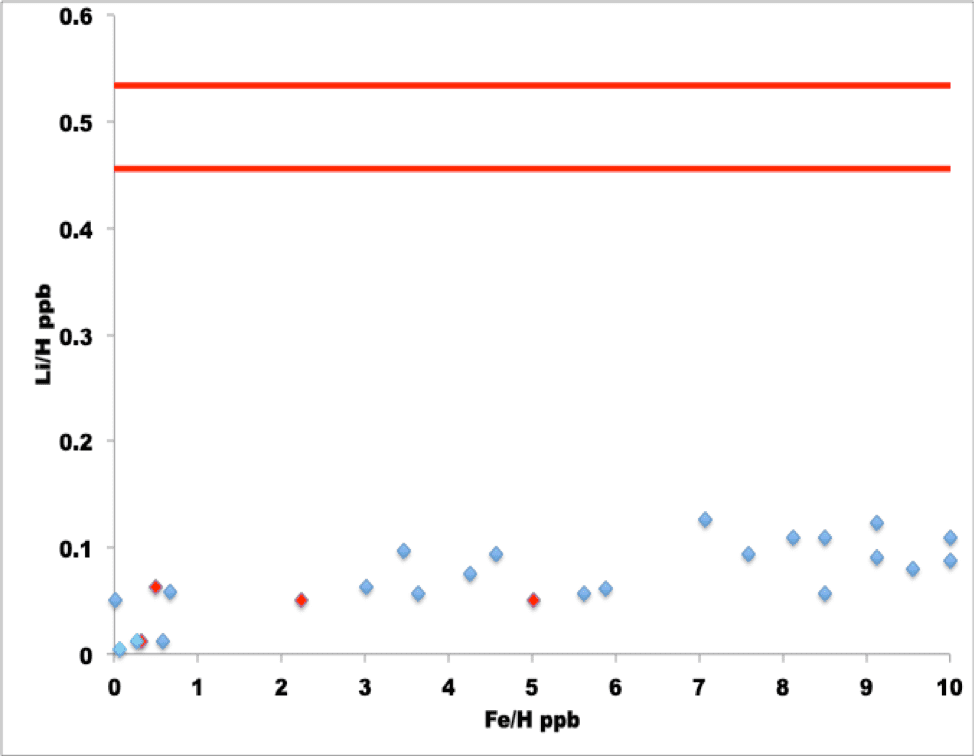
Li vs Fe abundance for the 26 known dwarf stars with Fe/H<10 ppb. These are the oldest stars, with the least contamination from earlier stars. Dark blue dots are measured values, red dots are Li upper limits and light blue dots are Li and Fe upper limits. The BBN predicted range of values is shown by the red solid lines. rk upper limits on lithium abundance of individual stars.
While these data flatly contradict the predictions of the Big Bang, they were predicted and simply explained by theories of galactic evolution that assumed there was no Big Bang, including a paper published in 1989 by Lerner. Lithium, as is well known, is produced by cosmic rays, emitted by early stars, crashing into carbon and oxygen nuclei, as well as by stars in their giant phase. The same stellar processes, Lerner showed, could produce the observed abundance of helium—from thermonuclear reactions in early intermediate-mass stars—and deuterium (again from cosmic rays), while producing the observed amounts of heavier elements like carbon and oxygen.
The new study includes new calculations based on this GOLE hypothesis that show that not only do early stars produce the observed amounts of helium, deuterium and lithium, but that they also produce other elements such as carbon, boron and beryllium in the amounts observed in the oldest stars. “The GOLE hypothesis was first published in a full form in my own paper in 1989 and had been discussed by others even earlier” explains Lerner. “Those published predictions have been confirmed by decades of subsequent observations, unlike the predictions of the Big Bang hypothesis. The new work that I am reporting at this conference makes the predictions more precise and is based on the much more extensive knowledge we now have of stellar evolution.”
These conclusions, based on observations of old stars in our galaxy, are strengthened by recent observations of the conditions in newly-formed galaxies. These galaxies are ultra-luminous, converting hydrogen to helium at hundreds of times the rate of our galaxy at present. Work by other researchers published in the last year show that their luminosity is driven by stars of about 8 solar masses and above, as had been predicted by the GOLE hypothesis.
2. Surface Brightness
The hypothesis that the universe is expanding is a basic pillar of the Big Bang theory. But observations of the size and brightness of thousands of galaxies contradict predictions based on the Big Bang expansion hypothesis, thus shaking this key pillar as detailed in a paper in MNRAS by LPPFusion Chief Scientist Eric Lerner, titled “Observations contradict galaxy size and surface brightness predictions that are based on the expanding universe hypothesis”, which finds that none of the published expanding-universe predictions of galaxy-size growth fit the actual data. All of the proposed physical mechanisms for galaxy growth, such as galaxy mergers, also contradict observations. However, the paper finds that the data are closely fit by the contrary hypothesis that the universe is not expanding, and that the redshift of light is caused by some other, currently unknown, process.
This research tests a striking 1930s prediction of Big Bang hypothesis that objects at great distances should actually appear larger, not smaller. According to the hypothesis, this is because of an optical illusion due to the galaxies having been much closer when their light was emitted.
This prediction was repeated in the literature through the 1980s but in the 1990s, the Hubble Space Telescope did not confirm the prediction. Hubble’s images instead showed that the most distant galaxies do in fact look the smallest. A group of researchers then formulated an additional hypothesis that galaxies actually grow in size with time. So very distant galaxies, viewed as they were billions of years ago, were theorized to have been much smaller than present-day ones. In this way, the smaller intrinsic galaxy sizes of the 1990s galaxy-growth theory neatly cancelled out the 1930s optical illusion prediction.
In Lerner’s paper the quantitative, published, predictions of the galaxy-growth theories were tested against the observed sizes of thousands of both spiral and elliptical galaxies, using HST observations from the period 2004-2014. The paper limited the samples to galaxies that have close to the same UV brightness. (Brighter galaxies are larger.) The observed data did not come close to fitting the predictions that galaxy size grows in proportion to the rate of expansion of the universe (Figure 1).
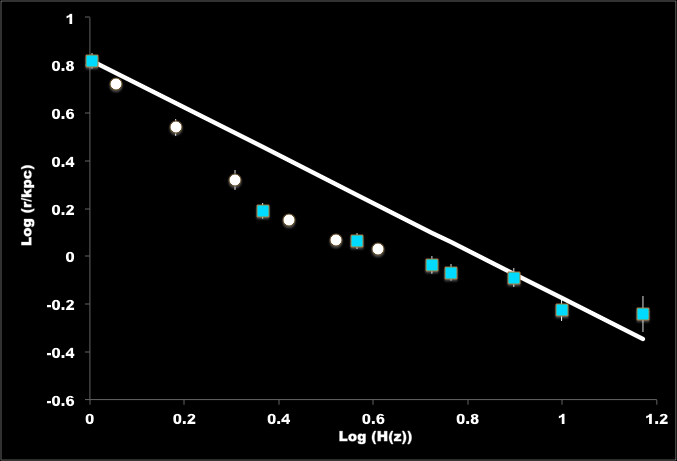
Figure 1. Log of the median radius of galaxies (in kiloparsec where 1 kiloparsec is 3,260 light-years), calculated with the expanding universe formula, are plotted here against the log(H(z)), a measure of hypothesized cosmological expansion, a function of the red shift z. Red squares are samples of spiral galaxies, black circles are samples of elliptical galaxies. The black straight line is the closest prediction of galaxy size based on cosmological expansion and the hypothesized galaxy growth. It does not fit the data.
In addition, Lerner pointed out that the process hypothesized for the growth of elliptical galaxies—mergers with other galaxies—occurs at a rate nearly ten times too slow for the growth hypothesized. A still worse contradiction with observation is obtained by comparing the gravitating mass of distant galaxies, (calculated from rotational speed and size), with the mass of the stars in them, (calculated from their emitted light). The size predictions based on the expanding universe lead to a gravitating mass smaller than the mass of the stars, an obvious impossibility.
While the expanding universe predictions did not fit the data, Lerner found that predictions based on a non-expanding universe fit both the spiral and elliptical galaxies at all distances to an accuracy of a few percent. No matter what the distance, with a non-expanding universe, the galaxies of a given brightness were the same size, just as predicted by the non-expanding hypothesis. (Figure 2).
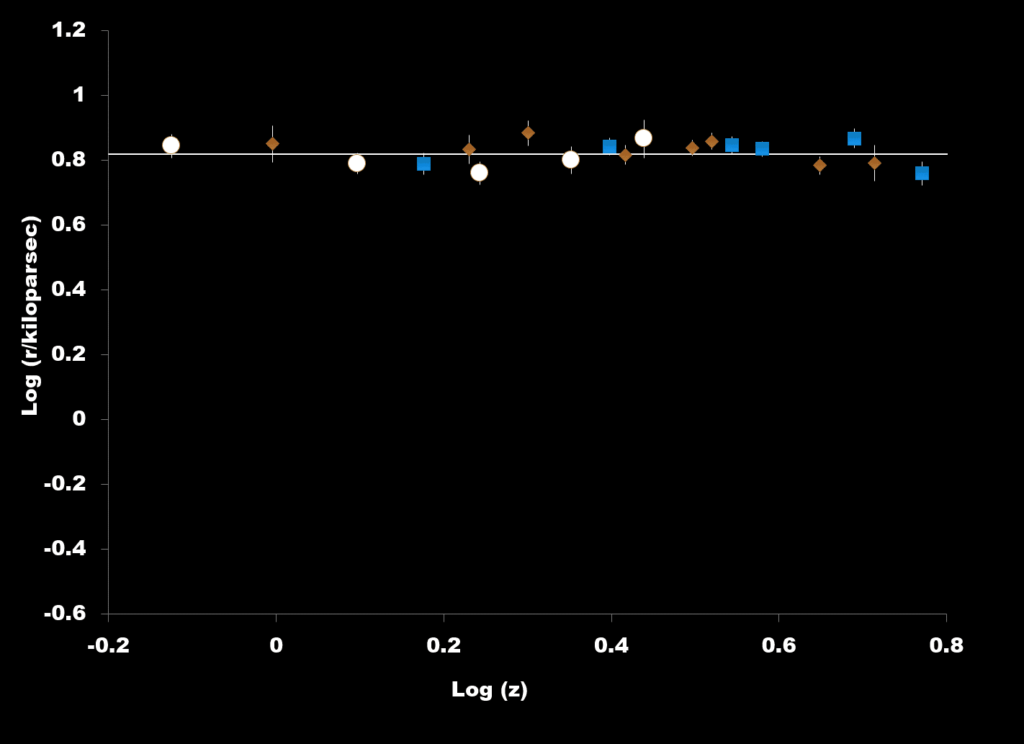
Figure 2. The log radius of galaxies assuming a non-expanding universe is plotted against the log of z, where z is the redshift. Black circles are samples of elliptical galaxies and blue and red symbols are samples of spiral galaxies. As predicted by the non-expanding hypothesis, the size remains constant for galaxies of the same brightness (luminosity).
“In this hypothesis, the simple linear relation between the redshift of light and distance is caused by something that happens to the light as it travels, not by the expansion of space,” Lerner explains. “Right now, no one knows what could cause this, but the linear relationship and a non-expanding space make predictions that fit the data, while the expanding universe predictions don’t fit. ”
The present research is an extension of earlier work done by Lerner at LPPFusion with colleagues Dr. Renato Falomo (INAF – Osservatorio Astronomico di Padova), and Dr. Riccardo Scarpa (Instituto de Astrofısica de Canarias, Spain) and published in 2014.
More background on this research can be found here.
3. Structures Too Large to Form in the Time Since the Hypothesized Big Bang
The Big Bang theory hypothesizes that the universe came into existence with an almost perfectly homogenous—even—distribution of matter, and that structures built up gradually from stars to galaxies to cluster to superclusters.
But larger and larger structures have been uncovered at earlier and earlier times. To cite one recent example of many, in 2013 a team of observers, Roger Clowes, et al, discovered a huge collection of quasars over 3 billion light years in extent, existing billions of years ago. This was, in their view, too large to have been created within the hypotheses of conventional cosmology. Even larger structures of galaxies where found in 2016 by Shirokov et al.
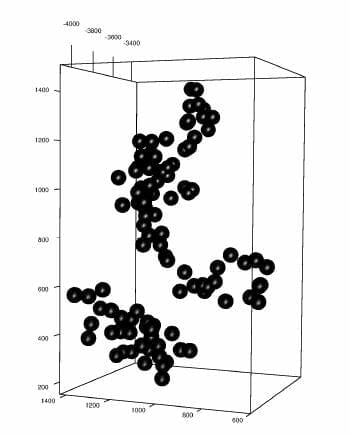
Figure 3. The huge agglomerations of quasars discovered by Roger Clowes et al. Tick marks are separated by 600 million light years. These objects are far too large to have been generated in the time since the Big Bang.
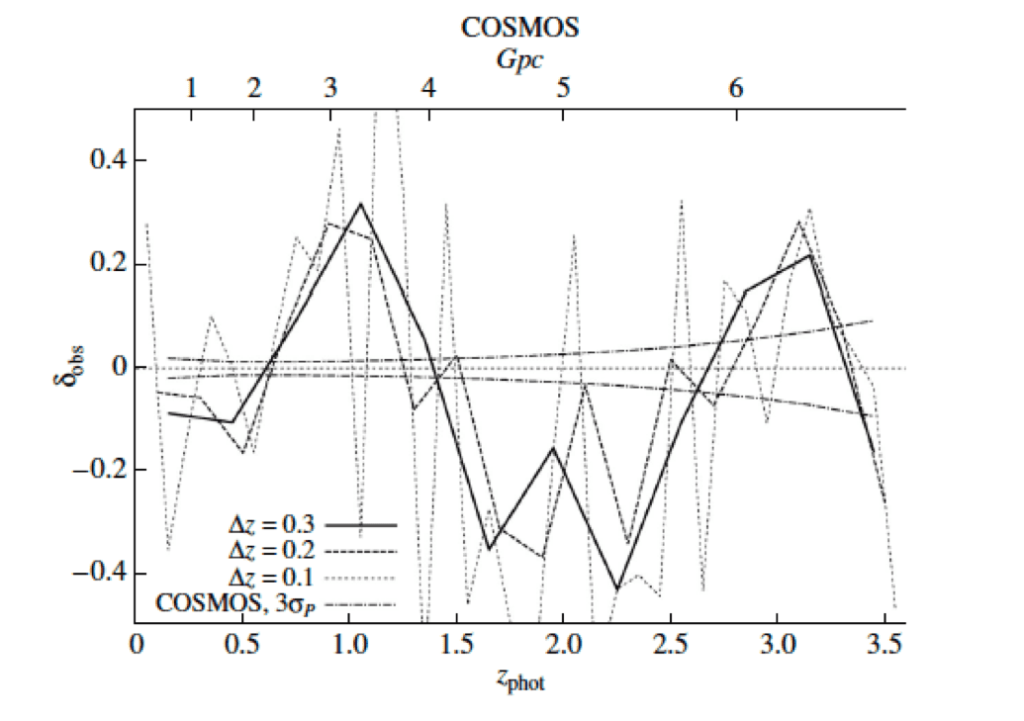
Figure 4. In 2016 Shirokov et al found similarly-sized conglomerations of galaxies. Here density of galaxies is plotted against redshift.
Indeed, Lerner has pointed out that, when the existing low velocities of galaxies are taken into account, the large structures of conglomerations of galaxies that we observe would take hundreds of billions of year to form. In pioneering work in 1986 Lerner used plasma physics to predict a fractal structure of the universe, including structures up to billions of light years across, structures that were later discovered. In Lerner’s theory, these structures could only have formed in a universe whose history stretches far back before 14 billion years ago.
4. The Cosmic Microwave Background Radiation and the Problem of Large-Scale, Non-Random, Asymmetries
The Cosmic Microwave Background Radiation (CMB) is frequently cited as the key evidence for the Big Bang, and for inflation, the super-expansion during the Big Bang that is a critical element of the theory. One of the few concrete predictions of inflation is that the universe is isotropic, the same in all directions.
The inflation theory predicts that any asymmetries in the universe existing before inflation would be wiped out by the vast expansion during inflation. “The most decisive observational evidence against inflation would be provided by evidence that the Universe possesses large-scale rotation,” wrote Barrow and Liddle in a 1997 paper.
But in fact the CMB evidence, combined with evidence from observations of galaxies, flatly contradicts the prediction of perfect isotropy.
The results from the Planck satellite confirmed what had been known for years, that there are non-random alignments on the sky of the small fluctuations in the intensity of the CMB. (These are only the most prominent contradictions of inflation predictions by Planck data).
In addition, a study of the handedness of spiral galaxies in 2012 showed a non-random alignment of the galaxy spins on a very large scale. Such spin alignments indicate precisely the large scale rotation that contradicts inflation. In 2019 Lee et al found coherent rotation in filaments of galaxies. The dynamical time to form such large, slowly rotating objects is on the order of a trillion years—they could not possibly have formed in the 14 billion years since the hypothesized Big Bang.
Researchers have for years attempted to find evidence of the Big Bang theory in the spectrum of anisotropies in the CMB—the plot of the power of the fluctuations versus their size on the sky. In order to fit the six bumps and seven dips in this curve, theorists have required seven free variables—the density of dark matter, of ordinary matter, of dark energy and four additional fitting parameters. Even so, the theory remains a poor fit to the spectrum at the largest scales—those of a few degrees or more, as can be seen in Figure 5, where the dips at 2 and 20 are entirely missed by the best theoretical fit.
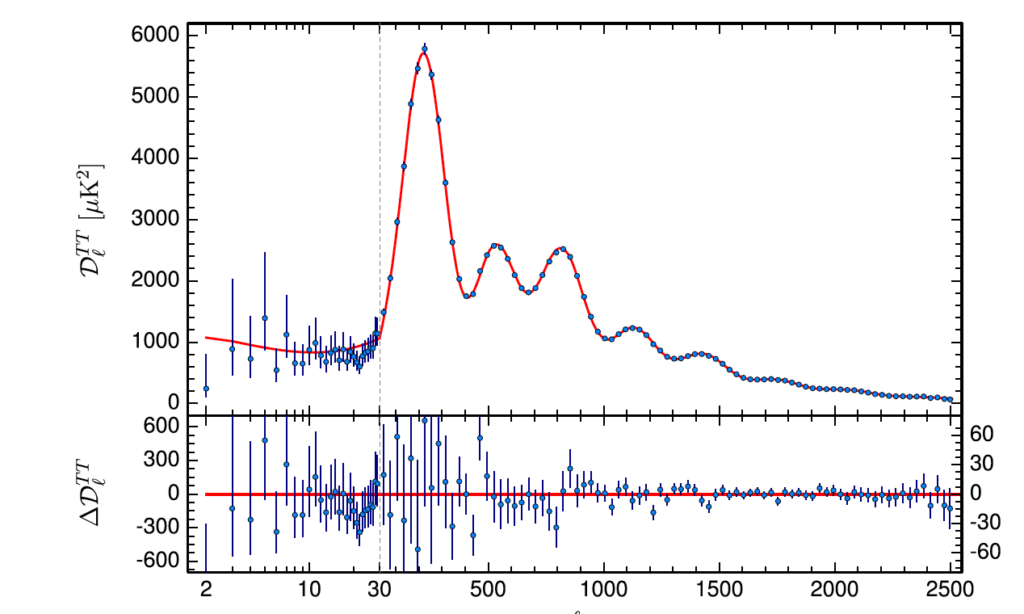
Figure 5. The amplitude of the anisotropies in the CMB are plotted against mode number. The larger the mode number, the smaller the anugualr size of the anisotropies. Note the big deviation form the fitted, red, curve at 2 and 20.
In the past two years, much attention was given to the fact that the value of the Hubble constant predicted by the fit to the CMB spectrum was different from the value actually measured by comparing the distance to supernovae with their redshifts. While this was described as. Difference between two measurements, it was in fact a failure of a theoretical prediction, based on fitting the CMB spectrum with the help of Big Bang theory. The only direct measurement was based on the supernovae data, which compare two observable quantities, the apparent brightness of the supernovae and the redshift of their spectrums.
The latest crisis paper by Eleonora Di Valentino, Alessandro Melchiorri and Joseph Silk details additional serious contradictions between predictions and observations, as well as inconsistencies in the predictions themselves. These authors point out that the parameters that fit the smaller scale part of the spectrum are different than those that fit the entire spectrum. In addition, if all seven parameters are used, the best fit is a combination of dark matter and dark energy that describes a curve, closed universe, not the Euclidean flat universe that is a prediction of inflation. On top of that, the amount of dark matter predicted by the best fit is so large that it would cause galaxies to move past each other much faster than observed. As well the new fits worsens the prediction of the Hubble constant.
In summary, despite the multiplication of fitting factors and the addition of dark energy and dark matter, the Big Bang predictions concerning the CMB fail in every direction.
There are alternative explanations of the CMB that do not require a Big Bang. It has been known for decades that the energy needed to account for the microwave background is equal to the energy that would have been released by the production by ordinary stars of the known amount of helium. In addition, the isotropy and black-body spectrum of the CMB are inevitable if the intergalactic medium is not perfectly transparent to microwave radiation. Indeed evidence has been accumulating for 30 years that this is the case. The CMB is a radio fog permeating the present-day universe, not some ghost of a long-ago Big Bang.
If the universe scatters or absorbs microwave and radio radiation, but is transparent in the shorter-wavelength infrared bands, then more distant objects will appear dimmer in radio bands then in IR. Lerner first published observational evidence of this absorption effect in 1990 and 1993, showing that radio emission by galaxies dropped by a factor of 10 as distance increased to 200 Mpc. This distance corresponds to a look-back time of only 600 MY, too short a time for any evolutionary process to create such a dramatic change.
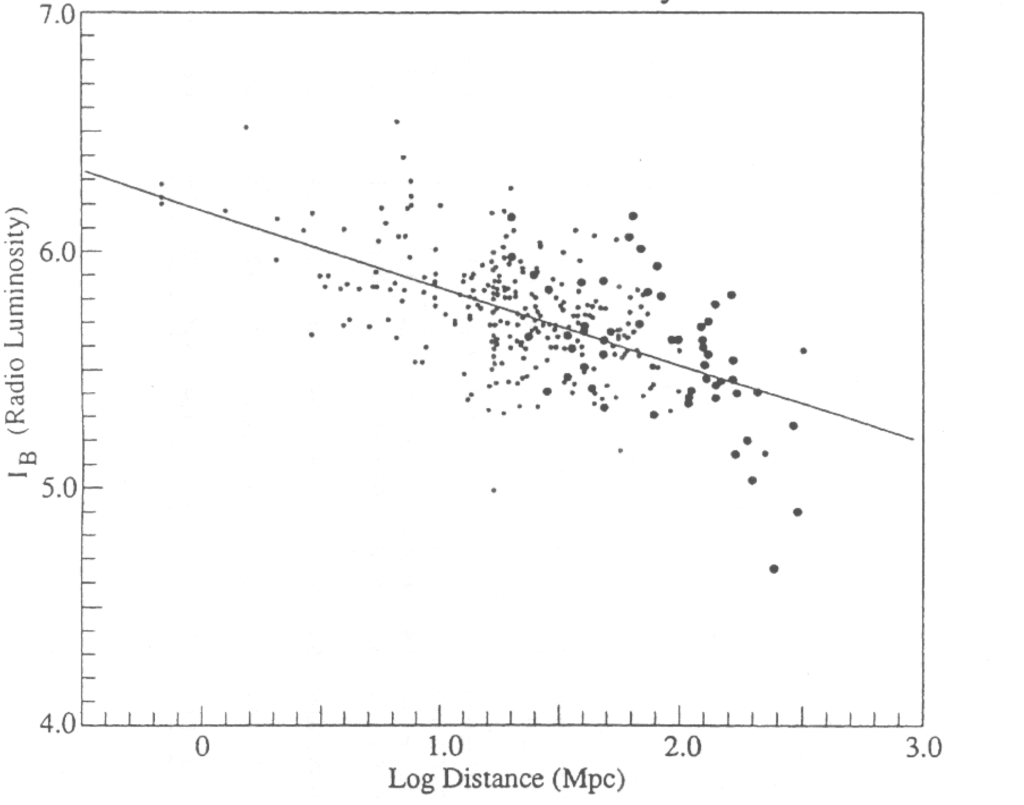
Figure 6. This graph, from Lerner’s 1993 paper shows the logarithm of radio luminosity of galxies plotted aginst the log of the distance. The corrleation can only be explained by a strong asborption in the IGM.
In the past decade, much deeper surveys have shown that this same trend of radio dimming with distance continues to higher z. While by itself this dimming over much large distance and thus much greater look-back times could be interpreted as some sort of evolution, the fact that it is continuous with the much shorter-range effect analyzed 30 years ago rules out a purely evolutionary explanation. Lerner found that for nearby galaxies with redshift z<0.07 radio emission falls as z-0.32. An evolutionary process accounting for this change in brightness with distance would have to accelerate ridiculously as it approached the present, with galaxies doubling in brightness in the last 10 million years alone.
Not only does the observation of radio-frequency absorption allow the production of an isotropic black-body CMB in the present-day universe, it rules out the hypothesis that the CMB was created by a Big Bang. Absorption of such radiation would dim its spectrum to a grey-body, not a black-body shape, something clearly contradicted by observation.
There are at least two phenomenon that could account for the absorption of microwave and RF radiation. Lerner had derived from plasma theory a prediction that radiation in these wavelengths would be absorbed and reemitted by electrons trapped in dense plasma filaments emitted from a range of astrophysical jets extending from stellar Herbig-Haro objects to quasars. In addition, other researchers have pointed out that spinning dust particles can also absorb and re-emit microwaves.
5. Evidence Against Dark Matter
The Big Bang theory, in its current form, predicts that most matter in the universe is dark matter, unlike any that has been found on earth.
Increasingly sensitive experiments on earth have failed to turn up any evidence of the dark matter particles that are firmly predicted by the Big Bang theory. But in addition, astronomical evidence as well has ruled out dark matter. The simplest evidence is in the relatively low velocities of galaxies in the universe. (These can be measured for galaxies for which there are independent, non-redshift-based measurements of their distance. The redshifts can then be used to measure velocities of galaxies relative to one another.) The large amounts of dark matter predicted by the Big Bang would generate gravitational forces that will whip the galaxies around at hundreds of km per second. But the observed average velocities of 50 km/sec rules out the large amounts of dark matter required by the Big Bang, as Baryshev, Sylos-Labini, Montuori, Pietronero and Teerikourpi have pointed out. Nor would a super-smooth distribution of dark matter needed to avoid high velocities be compatible with the lumpiness—inhomogeneity—of matter that is observed on all scales.
In addition, the satellite galaxies of both the Milky Way and the nearby Andromeda galaxy are in a disk configuration, just as expected if the gravitating mass is ordinary matter. If the gravitating mass were dark matter, the satellites would have to be in a random sphere. This evidence completely contradicts the dark matter hypothesis, as Pavel Kroupa, among many other researchers, has pointed out.
Perhaps most decisively, Oehm and Kroupa in 2018 showed that the viscosity effect that is inevitable with dark matter would cause groups of galaxies to merge so rapidly that very few would be observed, in contrast with the many such groups that actually exist.
Again, there are other, simpler, non-Big Bang ways of explaining the data. Over 30 years ago, Peratt and Green showed that electromagnetic forces would produce the constant velocity of rotation in spiral galaxies that has long been used as a key evidence of dark matter. These velocities are measurements of the velocity of radio-emitting plasma within a galaxy, which is as much influenced by magnetic forces as by gravitational forces.
Jolacha, Bratek and others have shown that in the outer regions of galaxies, including the Milky Way, gas moves faster than stars and that this difference can be explained by the influence of magnetic fields on the gas. More recently Kounkel and Covey provided strong evidence of the influence of magnetic fields on the motion of stars as well. They found that a large fraction of nearby stars are embedded in filaments that have endured for hundreds of MY of even GY. While the authors don’t draw this conclusion in their paper, it is clear that gravitational forces alone can’t create long-lasting filamentary structures. However, magnetic fields with observed
strengths can dominate the dynamics of filaments of dense gas and these filaments can in turn gravitationally control the motion of the stars within them. Magnetic fields, rather than hypothetical dark matter, can provide the additional confining forces observed in galaxies.
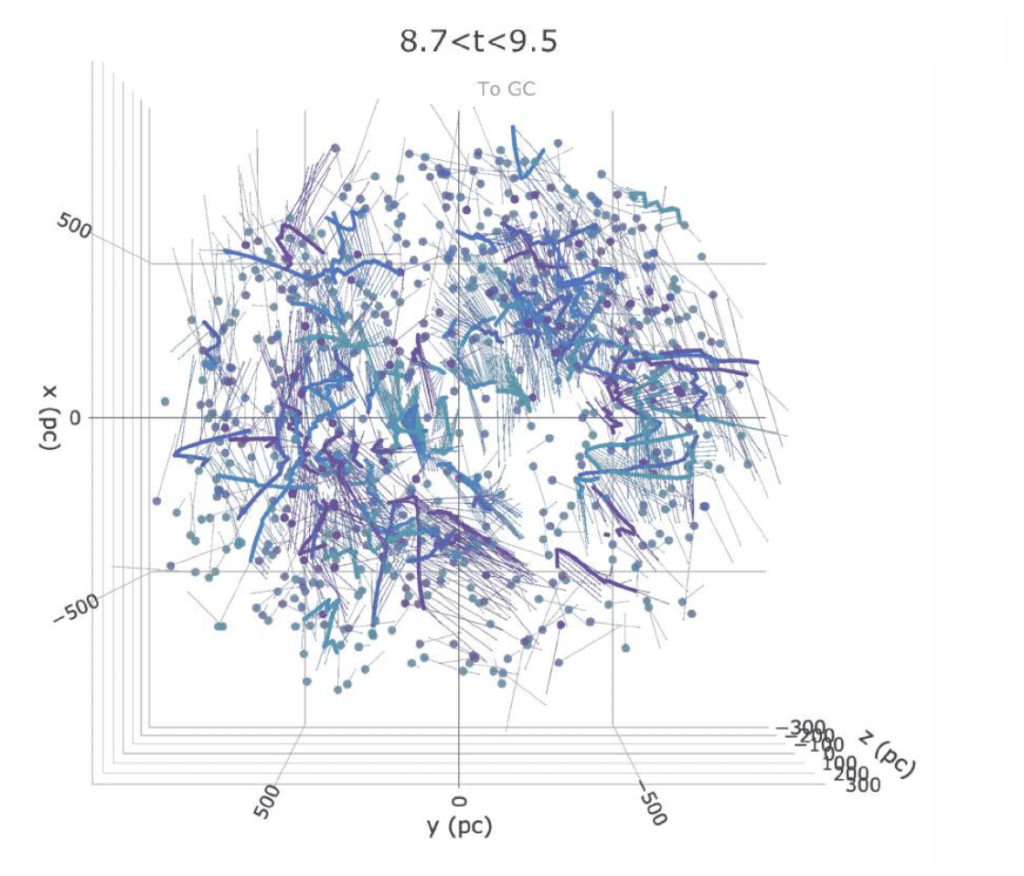
Many researchers, including Dr. Scarpa, have demonstrated evidence that a small modification of gravitational forces, termed MOND, could also explain the data.
Conclusion
Each of these sets of problems could be, and in fact often are, dismissed as mere “anomalies” in an otherwise well-supported theory. But taken collectively they contradict all the predictions of the theory, leaving no support at all. The response of supporters of the Big Bang theory has been to continually add “parameters” to the theory to account for new discordant data. As a result, as Michael Disney has demonstrated, the theory, now with over 20 parameters to be adjusted, has never had any power to predict new results. So it lacks the basic hallmark of a sound scientific theory. Indeed, the recent, well-publicized results from the BiCEPS instrument has led many researchers to add yet more parameters to the theory to explain apparent contradictions between BiCEPS and Planck results.
In contrast, the data that contradicts the Big Bang theory can be explained far more simply with hypotheses that are consistent with a universe that had no beginning in time and no Big Bang.
To delve deeper here’s a list of earlier (pre-2005) references.
